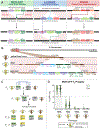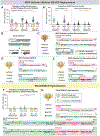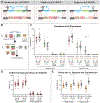Active Genetic Neutralizing Elements for Halting or Deleting Gene Drives
- PMID: 32949493
- PMCID: PMC10962758
- DOI: 10.1016/j.molcel.2020.09.003
Active Genetic Neutralizing Elements for Halting or Deleting Gene Drives
Abstract
CRISPR-Cas9-based gene drive systems possess the inherent capacity to spread progressively throughout target populations. Here we describe two self-copying (or active) guide RNA-only genetic elements, called e-CHACRs and ERACRs. These elements use Cas9 produced in trans by a gene drive either to inactivate the cas9 transgene (e-CHACRs) or to delete and replace the gene drive (ERACRs). e-CHACRs can be inserted at various genomic locations and carry two or more gRNAs, the first copying the e-CHACR and the second mutating and inactivating the cas9 transgene. Alternatively, ERACRs are inserted at the same genomic location as a gene drive, carrying two gRNAs that cut on either side of the gene drive to excise it. e-CHACRs efficiently inactivate Cas9 and can drive to completion in cage experiments. Similarly, ERACRs, particularly those carrying a recoded cDNA-restoring endogenous gene activity, can drive reliably to fully replace a gene drive. We compare the strengths of these two systems.
Keywords: CRISPR; Drosophila; ERACR; MCR; active genetics; drive-neutralizing; e-CHACR; gene drive; modeling; risk management.
Copyright © 2020 Elsevier Inc. All rights reserved.
Conflict of interest statement
Declaration of Interests E.B., V.M.G., and O.S.A. have equity interest in Synbal Inc. (E.B. and V.M.G.) and Agragene (E.B., V.G., and O.S.A.). These companies may potentially benefit from the research results. E.B. and V.M.G. also serve on the Board of Directors and Scientific Advisory Board for Synbal Inc., and E.B., V.M.G., and O.S.A. serve on the Scientific Advisory Board for Agragene Inc. The terms of these arrangements have been reviewed and approved by the University of California, San Diego, in accordance with its conflict-of-interest policies. All other authors declare no competing interests.
Figures








References
-
- Bastock M (1956). A gene mutation which changes a behaviour pattern. Evolution 10, 421–439.
Publication types
MeSH terms
Substances
Grants and funding
LinkOut - more resources
Full Text Sources
Other Literature Sources
Molecular Biology Databases

